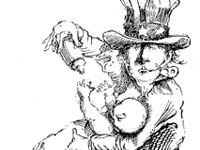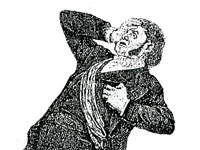ALLEGHENY CEMETERY
Lawrenceville’s largest landmark is an idyllic resting place.
Spring 2009

Within the cemetery, beautiful statues and monuments can be found at every turn.
ALLEGHENY CEMETERY
If a cemetery can be romantic, Allegheny Cemetery in Lawrenceville is the ultimate setting. Situated on the southern slope of the Allegheny River, its rolling hills, winding roads, ponds, wildlife, and natural beauty provide a picturesque and contemplative backdrop in which to pay respect to those who have gone before us.
In 1844, Pittsburgh, with a population of perhaps 30,000, was rowing. Though there was not a single blast furnace in Allegheny County and Andrew Carnegie was but nine years old, Pittsburgh was already known both as the “Smoky City” and the “Iron City.” It was manufacturing town,making glass, paper, steam engines, and, principally, iron, and Pittsburgh’s small iron-making foundries and workshops—all fueled by coal—were just the prelude to becoming the steel-making capital of the world over the next 60 years.
Growth had unexpected consequences, of course, one of which was that urban churchyards became overcrowded with graves, and churches had nowhere to expand. Members of downtown Pittsburgh’s Trinity Episcopal Church and the First Presbyterian Church thus explored the idea of creating a separate, interdenominational, landscaped cemetery.
“The movement out of churchyards into decorative, ‘rural’ cemeteries gained momentum in the 1840s and 50s,” says architect and Allegheny Cemetery board member Ellis Schmidlapp. “Americans quit burying people in the churchyard and moved out to the suburbs for interment in a pastoral setting, and Allegheny Cemetery’s claim to fame is that it is Pittsburgh’s first ‘rural’ cemetery.”
Allegheny Cemetery was incorporated in 1844, and the following year the search for suitable land led to Colonel George A. Bayard’s 100-acre farm and homestead in Lawrenceville, which the 40 corporators purchased for $50,000. The site was more than three miles upriver from the Point.
The cemetery’s first superintendent, John Chislett, an Englishman and foremost architect in Pittsburgh at the time, was then instructed to survey and lay out the property, described by Pittsburgh historian James D. Van Trump as being “in the fashionable Romantic landscape style.” Chislett also designed the cemetery’s Butler Street gate and lodge.
With additional land purchases, the cemetery is now 300 acres—half the size of Frick Park—making it the largest landmark in Lawrenceville.
Tom Roberts, president of Allegheny Cemetery, recognizes its significance to the neighborhood. “We are the largest constant in Lawrenceville,” says Roberts. “We go back 165 years. Lawrenceville has changed in many ways. It’s gotten bigger, it’s gotten smaller, but anyone who has been a part of Lawrenceville probably played in the cemetery.We have walkers and joggers.The people of the community think of this as theirs, and they have taken ownership of it. And over the years we have employed an awful lot of people from this area, so I think it’s a large, large part of this community.”




The array of headstones, monuments, and mausoleums within the cemetery include (top) a memorial to one man’s passion for the film Jaws, (middle) many familiar Pittsburgh names, (above) countless angels, and (top right) varying architectural styles, like this Greek temple-like mausoleum. (All photos on this page are by Charlie Stewart.)
As those walkers and joggers make their way along the 15 miles of meandering roads on the cemetery grounds, they glimpse thousands upon thousands of unique markers, monuments, and mausoleums reflecgting an inummberable array of styles from Grecian Doric to Egyptian to Gothic to Romanesque and to the unusual and even the humorous. Lester C. Madden loved the movie Jaws so much that the gaping mouth and the sharp teeth of the Great White Shark are engraved on his headstone.
A newly-completed website project, www.webcemeteries.com, enables people to access their relatives’ records online and shows the location of all of Allegheny Cemetery’s 130,000 interments.
One of themost famous is Lawrenceville’s own Stephen Collins Foster, born nearby on July 4, 1826. He composed numerous works, including Oh! Susanna, Camptown Races, and My Old Kentucky Home. As popular as his songs were, he died in poverty in New York in 1864 after a severe fall. The funeral cortege was met at the gate of Allegheny Cemetery by a company of musicians playing Come Where My Love Lies Dreaming and Old Folks at Home.
Each year on January 13, the anniversary of his death, Allegheny Cemetery invites the public to attend a memorial service where Foster’s life and songs are celebrated together.
“We tell the history of the people who are here,” says Roberts. “So we are responsible for maintaining the history of the families. That’s why we do a lot of public service activities, tours, and events, and the Stephen Foster memorial service. We have been doing that for 138 years, remembering him on the day he died.”
And this summer, on July 11, in observance of Foster’s birthday, there will be bands playing Stephen Foster-era music, educational tours of Allegheny Cemetery, costumed re-enactors, and other outdoor activities.
Other notable names engraved intomonuments read like the street signs of East End neighborhoods— Negley, Howe, Frew,Wilkins, and Baum.
So much of the energy behind the story of Pittsburgh rests here: Thomas Mellon (banking), Joseph Horne (Pittsburgh’s first department store), “Rosey” Rowswell (the Pirates’ first full-time announcer), Lillian Russell (popular 19th century actress and singer), General Alexander Hays (Civil War veteran), Josh Gibson (catcher for the Pittsburgh Crawfords)….the list goes on.
And 22 of Pittsburgh’s mayors are interred in Allegheny Cemetery, including Ebenezer Denny, witness to the surrender of Cornwallis in the American Revolutionary War and Pittsburgh’s first mayor. “That’s my great-great-great-great-grandfather,” says Harmar D. Denny IV, board member and chairman of the Allegheny CemeteryHistorical Association. He recalls the family “junkets” on holidays when his mother brought birdseed to feed the flocks at their ancestors’ 40-plus gravesites.
Now it’s his turn to look after them. “Usually when I go to the cemetery for a meeting and can get down there early, I’ll swing by the lot.” says Denny. “Even if I don’t get out of the car, I’ll just drive by, checking on everybody there. I have to be the caretaker.”

Not everyone buried in Allegheny Cemetery is in Pittsburgh’s Who’s Who. “At one time people thought this was for the carriage trade,” says Roberts. “But even from the beginning we have buried people of very modest means. We have thousands of graves of people which were never even marked because they had nothing to mark them with.”
The late Walter C. Kidney, historian for Pittsburgh History & Landmarks Foundation, wrote in 1990, “The [Allegheny] Cemetery that you see today is thus a coming-together of several different things: the nature of terrain, the fact of human mortality, human ways of responding to the fact, circumstances of economy and technology, and the approaches of well-meaning people over a century and a half to the reconciliation of all these things in a beautiful place for honoring the dead.” And the idyllic landscape, as well as the memories, are to be tended to like a garden. “I believe,” says Denny, “that one of the ways we live forever is we live on through the next generation. We give a piece of ourselves to our kids and to whomever we influence in our lives.Then we live on in them. So there are all those people at the cemetery, dead and gone, but their markers are there reminding us that they have preceded us andwe have a responsibility. I’ve got a little piece of benezer, that’s six times removed coming down, and I’m going to pass that on to my son. So all of these people will live forever in what we do.”
Beautiful dreamer, wake unto me,
Starlight and dewdrops are waiting for thee;
Sounds of the rude world heard in the day,
Lull’d by the moonlight have all pass’d away!
Beautiful dreamer, queen of my song,
List while I woo thee with soft melody;
Gone are the cares of life’s busy throng,
Beautiful dreamer, awake unto me!
Beautiful dreamer, awake unto me!
(Beautiful Dreamer, by Stephen Foster,
was published two months after his death.)
With many thanks to SHADY AVE magazine for granting me permission to reprint on my website.


